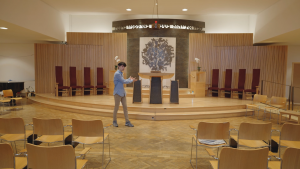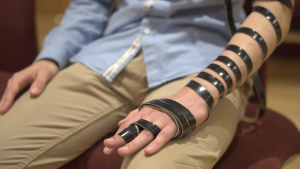The Torah is the Jewish holy scripture, and the scrolls play a central role in services at the synagogue. Zack and his rabbi demonstrate how the Torah is read, and the way a scroll is “dressed” afterwards to show its importance.
Check out Alephbeta to read more information on the Torah:
https://www.alephbeta.org/weekly-torah-portion
Curriculum Mapping
Component 1 - The study of religions: beliefs, teaching and practices - Judaism - Introduction to Judaism - Introduction to the idea of common and divergent views within Judaism. The synagogue and worship. Shabbat in the home and synagogue and its significance. Worship in the home and private prayer. The synagogue and worship - The written law (Tenakh) and the oral law (Talmud) and their study, use and significance in daily life.
Area of study 2 - Section 3 -Living the Jewish Life - Judaism - The nature and purpose of Jewish public acts of worship: the nature, features and purpose of Jewish public worship, including interpretations of Psalm 116:1219; the nature, features and importance of synagogue services for the Jewish community and the individual. Features of the synagogue: the nature, history and purpose of the different design of the synagogues in Liberal, Reform and Orthodox Judaism, including facing Jerusalem, layout of seating the Ark and the bimah and with reference to Proverbs 14:28; how and why the synagogue is used by the different communities, including reference to Exodus 27:20–21; how and why objects of devotion are used within the synagogues, including a yad, Torah Scroll, ner tamid and menorah. Section 3: Living the Jewish Life -The nature and purpose of Jewish public acts of worship: the nature, features and purpose of Jewish public worship, including interpretations of Psalms 116:12–19; the nature, features and importance of synagogue services for the Jewish community and the individual.
Component Group 1 - Judaism - Practices -Worship• The structure of the synagogue service •The importance of the synagogue, in relation to the following religious features: •• Design •• Artefacts •• Synagogue services •• The role of the synagogue within the Jewish community •• Worship in the home •• The place of worship in the home •The significance of the Ark, the Bimah, the lack of representation of G-d, the Ner Tamid and the Mikveh • The nature and importance of the Torah readings, other readings, prayers and sermons •The connection between the synagogue and the Temple • Issues related to worship and the synagogue, including the length and structure of synagogue services and different uses of Hebrew in the service • Common and divergent emphases placed on the features of a synagogue by different Jewish groups, including separating women and men in an Orthodox synagogue •Different interpretations and emphases given to sources of wisdom and authority by different Jewish groups Prayer• The role and importance of prayer in Jewish worship, including the Amidah (the standing prayer) • The role and importance of private prayer for Jews • The importance of: •• The three daily periods of prayer •• The concept of spontaneous prayer •• Recitation of the Shema •• Recitation of Grace after meals •• Teaching children to pray •• The direction faced when praying •• Prayer and the observance of the Mitzvot in the home • The importance of prayer for praise, confession, thanks giving and supplication.
2.1 Unit 1 PART A - Judaism - Core beliefs, teachings and practices - Worship in the home and synagogue The importance of the synagogue: internal features- aron hakodesh (ark), ner tamid, bimah, Torah, Ten Commandments, seating Reading of the Torah during synagogue worship Diverse practices within Orthodox and Reform synagogues – worship and the role and gender of the Rabbi The importance of the home for worship in Judaism: challenges and benefits of observing Shabbat (Exodus 20:8-10)
Component 3 (Route A) - Option 4: Judaism - Practices - The Synagogue ➢ Features of different synagogues in Britain: significance of bimah, aron hakodesh, Torah scrolls, ner tamid, seating, minyan; Exodus 20:4-5
Transcript
Judaism: The Torah Scroll
Zack: The reading of the Torah is the most important part of a service in a synagogue because we believe that it contains God's words. So a Torah scroll is treated with great respect, almost like a king. And before it's put away, it will be dressed in a robe and a crown. This is to protect it, but also to remind us of how important it is. Dressing or undressing. The Torah is called Galilee in Hebrew, and it usually takes two people to do it. One person rolls up the scroll and carefully lifts it up by the bottom handles of the rollers. Then another person can start the dressing by tying a sash or belt around the middle to keep the two rollers together.
This belt is called a Haggadah or a garter. Then the scrolls are covered with a mantle which is usually made from a rich material like velvet and often beautifully embroidered. There were two holes in the top for the handles of the rollers to poke through. In some shawls, a brass plate or hosen in Hebrew is added over the mantle. This is like a silver apron or bib on a chain and represents the breastplate that the priests used to wear in the temple in Jerusalem before it was destroyed nearly 2000 years ago. Sometimes the Yad the pointer will be hung over the top. Finally, the top of the tallest bar will be adorned with a crown. This might be an actual crown called a kettle that fits over the top of both roller handles or two finials or decorated caps that go on each handle. These are called Raman, which means pomegranates in Hebrew because they are often made to look like fruit called pomegranates. People used to believe that there were 613 seeds in each pomegranate, one for each of the commandments in the Torah. Now the scroll is carried very carefully to the Ark or the A1, which is a special cupboard at the front of the show where all the scrolls are kept and then the doors of the ark are closed.









